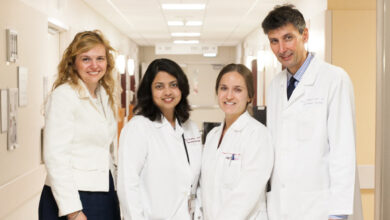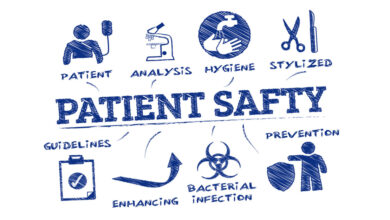Why BREAST CT instead of Mammography?
Why BREAST CT instead of Mammography?

Avice O’Connell, MD. FACR, FRCPI. Director, Women’s Imaging Professor, Imaging Science University of Rochester, New York
In general, women have been seeking change for decades and rightfully so! Dedicated cone beam breast computed tomography (CBBCT)is the latest in a long history of breast imaging techniques dating back to the 1960s. Breast imaging is performed both for cancer screening as well as for diagnostic evaluation of symptomatic patients. Dedicated breast CT received US Food and Drug Administration approval for diagnostic use in 2015 and again in October of 2017 for the redesigned commercial model. Breast CT is slowly gaining recognition for its value in diagnostic 3-dimensional imaging of the breast, and for injected contrast-enhanced imaging applications.
Conventional mammography has known limitations in sensitivity and specificity, especially in dense breasts. Although breast tomosynthesis (limited sweep angle linear tomography)was US Food and Drug Administration approved in 2011 and is now widely used, dedicated Cone Beam Breast CT (CBBCT) is the next technological advance combining Isotropic, 3-dimensional imaging allowing for the ease of contrast administration as needed; much like whole body CT imaging with and without contrast. CBBCT removes painful compression and manipulation of the breast currently required to obtain digital mammography (FFDM)or tomosynthesis (DBT) images. Since the beginning of mammography women have complained about painful compression. Dedicated cone beam breast CT provides a long-awaited answer to these complaints.
TOP 10 Reasons Cone Beam Breast CT (CBBCT) is needed
- It is the next technical improvement after mammography and tomosynthesis have reached their limits.
- One “view” only per breast, then we can “manipulate the image not the patient.”
- It is better for dense breasts (eliminates overlap).
- Reduces false positives and false negatives.
- Better resolution than MRI (CBBCT can achieve as high as 0.155mm3 resolution and can visualize fine calcifications).
- Ease of contrast administration when needed.
- Less costly to perform.
- Shorter time to perform than diagnostic mammography and MRI (10 second acquisition time).
- Improved patient comfort, no compression and no hands-on manipulation of the breast.
- 3D-guided biopsy reduces dose by over 50%
Why we need Breast CT – Problems with Mammography
- Mammography has Low sensitivity – 85% at best
- < 50% in dense breasts
- >40% of women in the US have dense breasts >80% in Asia
- Note: The risk of cancer in dense breasts is 4 – 6 X relative risk
- Compression (“masking” effect- overlapping structures)
- Uncomfortable
- Undignified procedure to withstand
- We need something better…
Why Breast CT – True Isotropic 3D Imaging
- Breast is a 3D structure – 2D imaging is subjective leading to much more additional imaging
- Compression increases problematic tissue overlap
- Mammography has distortion –false positives and false negatives
- Women don’t like it!
Simply stated, there is a need to detect breast cancer at the earliest possible stage, ideally before it becomes invasive. Recent national benchmarks show that 76.9% of cancers detected by screening digital mammography are stage 0 or 1, indicating that one- fourth of the cancers are not detected early enough. Imaging of the breast needs a high-resolution, high-contrast technology capable of both detecting calcifications as small as a few hundred microns, as well as subtle density differences to be able to detect early cancers. This requires moving beyond mammography and recognizing that it is also important to plan for contrast administration. When a contrast enhanced examination is indicated, it needs to be performed at an acceptable radiation dose.
CBBCT utilizes a high-quality mammography X-ray tube and detector placed onto a slip ring very similar to whole body CT scanners although utilizing radiation doses in the same range as diagnostic mammography. Since all of imaging exists in a continuum, it can be understood as to how breast imaging exemplifies this concept. From the earliest experiences in breast imaging in the 1960s, imaging of the breast has evolved through xeromammography, screen-film mammography, digital mammography, and now breast tomosynthesis. Breast imaging has become more sensitive and specific with each technological advance. Each technology ultimately reaches a performance plateau, and subsequent technological advances are needed such as with digital mammography gradually giving way to breast tomosynthesis. At this time, breast tomosynthesis is the closest mammography can come to 3D imaging. It is a technique, allowing several low- dose slices of the breast to be reconstructed in planes parallel to the detector. However, it still has many of the limitations of 2-dimensional mammography such as compression and substantial tissue overlap between successive slices, particularly in dense breasts. Limited angle linear tomography or in the case of breast imaging, digital breast tomosynthesis, suffers from SSP (Slice Sensitivity Profile), a condition that is avoided by introducing Isotropic 3D imaging only found in CT imaging. CBBCT is the next technical development, allowing for true Isotropic 3D imaging of the uncompressed breast resulting in visualization of potential abnormalities equally from any angle.
Need 3D Imaging for a 3D Structure
If we were to start designing an imaging system today for early detection of breast cancer, the current method of compression 2-Dimensional mammography would almost certainly not be the first choice. Requirements would include low radiation dose, some form of 3D imaging that would not require vigorous and often painful compression of each breast twice for the initial screening and to replicate how cancer is detected in the rest of the body via CT imaging with and without contrast. CBBCT provides all these modern benefits, eliminates many of the well documented limitations of FFDM and DBT and will stand as an effective and efficient alternative to breast MRI.















